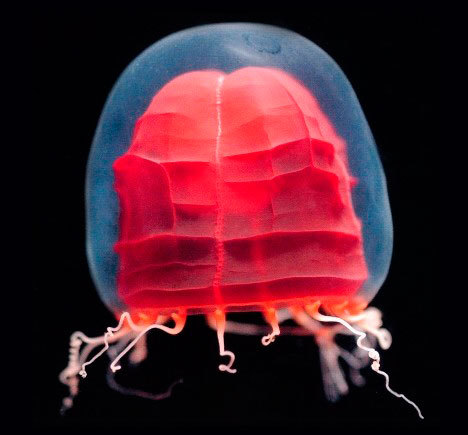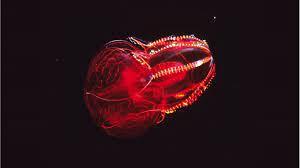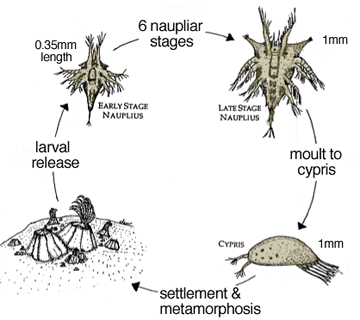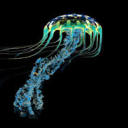Predatory Copepod

Predatory Copepod
Paraeuchaeta barbata
Copepods are a type of zooplankton or tiny creature that feeds larger animals in the ocean such as, fish. They are crustaceans that have two long antennas and a sensory eye called an ocelli, which can only sense light. This copepod is located between 200m to 1500 m in the deep ocean. You may notice the copepod is red in color. The color is an adaptation that makes it difficult for predators to see the copepod because red wave lengths do not penetrate this depth (mostly blue and indigo light). Even though this creature tiny, it is a vital food source for many animals in the abyssal zone of the ocean.
Photo credit: http://www.arcodiv.org/watercolumn/copepod/Paraeuchaeta_barbata_large.html
More Posts from Bioluminescentoceangoddess and Others
Pyrocystis fusiformis is a common plankton that produces bioluminescence. Not exactly a marine animal, but an amazing organism that produces bioluminescence. So, I thought it was worth sharing on this page.



Pyrocystis fusiformis
Pyrocystis Fusiformis is a marine dinoflagellate that is non-motile and has a short life cycle (5-7 days). When disturbed, the dinoflagellate displays vibrant, blue bioluminescence. The bioluminescence is design to startle grazers, or cause them to glow, making them more vulnerable to predators. During the day, it uses photosynthesis to produce its own food, and it produce bioluminescence at night. Furthermore, it fixes carbon from the ocean and produces oxygen for the marine animals that live there. All in all, I find this diamond shaped plankton to be unique and beautiful.
Photo credit: https://fineartamerica.com/featured/2-bioluminescence-of-pyrocystis-fusiformis-gerd-guentherscience-photo-library.html
https://exploringtheinvisible.com/2013/11/21/c-mould-new-acquisition-pyrocystis-fusiformis/
https://www.flickr.com/photos/13084997@N03/32823053106


Physonect Siphonophore
Nanomia cara
The Physonect siphonophore has tiny, bubble shaped sacs that are filled with gas. The sacs are called pneumatophores and help this creature move through the deep ocean. It also has venomous tentacles that stun prey and over eighty stomachs. There are numerous amounts of these strange creatures along the east coast, and they have cause some fisheries to collapse. Furthermore, they can be found at depth between 400m to 1000m.
Photo credit: http://www.seawater.no/fauna/cnidaria/cara.html
https://www.mindenpictures.com/stock-photo-siphonophore-hydrozoan-cnidarian-nanomia-cara-atlantic-nectophores-naturephotography-image90194961.html

Threadfin Snailfish
Careproctus longifilis
The Threadfin Snailfish resembles a prehistoric tadpole that is ghostly white. The holes in its face are large sensory pores that help them detect changes in the ocean. It is often found at depths between 1900 to 2997 meters.
Photo credit: https://www.timeout.com/singapore/museums/creatures-of-the-deep


Pink Helmet
Aglantha digitale
The Pink Helmet is a mini hydromedusa that comes in a variety of vibrant colors. The tiny jelly is only 4 cm in size and is found towards the surface of the ocean. The purple and blue hues we see in its bell are caused by a phenomenon known as iridescence, when light strikes the jelly’s thin tissue at different angles (similar to what we see in a soap bubbles). It also has orange pigmentation near its mouth; this pigmentation helps attract prey and mask luminescence. Furthermore, females tend to be more colorful than males.
Photo credit: https://biolum.eemb.ucsb.edu/organism/pictures/aglantha.html
https://www.pinterest.com/pin/186899453255850798/


Sea elephant
Carinaria japonica
The Sea Elephant is a translucent sea snail that has a large muscular body and a tiny triangular shell. Its foot is used for crawling on the ground, and it can be transformed into a fin that is used for swimming. It is called the “sea elephant” because it has a small trunk in its mouth that is used to swallow prey. Furthermore, the Sea Elephant eats arrow worms and jellies.
Photo credit
https://bodegahead.blogspot.com/2014/12/carinaria-part-2.html
http://tolweb.org/Carinaria_japonica/28750
Dear ocean enthusiast and supporters,
Hi everyone, thank you for supporting my blog. I have gained over 500 followers and that is worth celebrating. I will try my best to post every day some of the amazing creatures that live in the deep ocean. Have a great night!


Red Paper Lantern Medusa
Pandea rubra
The Red Paper Lantern resembles a floating, Japanese paper lantern in the deep sea. It has the ability to crumple and wrinkle its bright, red bell, and it is located at depths between 550m to 1200m. It has also been nicknamed the “origami jelly.”
Photo credit: https://commons.wikimedia.org/wiki/Category:Pandea_rubra
http://www.thegorgeousdaily.com/pandea-rubra/
An amazing glowing ctenophore!


Bloody-belly comb jelly
Lampocteis cruentiventer
The Bloody-belly is a 16 cm ctenophore that is found at depths 700 m to 1200m. It is crimson red in color and appears black in the deep ocean. However, the jelly has the ability to emit a different color. Furthermore, it uses highly iridescent ctenes to propel through the water.
Photo credit: https://laughingsquid.com/bloody-belly-comb-jelly/
https://www.reddit.com/r/deepseacreatures/comments/2j1717/bloodbelly_comb_jelly_lampocteis_cruentiventer/
Update
Hi everyone, I apologize for the inconsistent posting. I’ve been studying for my Chemistry Praxis. :( There will be more to come soon !
If you are interested in learning about different types of plankton in the ocean, please check out @planktonqueen page. I post a lot of cool species, photos, and facts.


Barnacle Larvae
Amphibalanus eburneus
When we think of barnacles, we think of the hard, white crustaceans that grow on the side of boats and docks. However, barnacles go through a variety life stages and metamorphosis before they spend their life on a hard surface. The image above is a barnacle larvae when it is in the cypris stage, think of it as a baby barnacle. This larvae is an example of zooplankton and spends a short period of time floating around in the water column. The second image summarizes the life cycle of a barnacle.
Photo source: https://www.nyharbornature.com/blog/barnacles-are-reproducing
https://www.pinterest.com/pin/453174781229895797/
-
 eyejuice reblogged this · 11 months ago
eyejuice reblogged this · 11 months ago -
 eyejuice liked this · 1 year ago
eyejuice liked this · 1 year ago -
 thkinnypuppy liked this · 2 years ago
thkinnypuppy liked this · 2 years ago -
 chimugukuru reblogged this · 2 years ago
chimugukuru reblogged this · 2 years ago -
 dimens1ons liked this · 3 years ago
dimens1ons liked this · 3 years ago -
 joshurequiem liked this · 3 years ago
joshurequiem liked this · 3 years ago -
 tyana-bt liked this · 3 years ago
tyana-bt liked this · 3 years ago -
 mellowmelancholia reblogged this · 3 years ago
mellowmelancholia reblogged this · 3 years ago -
 wachinyeya reblogged this · 3 years ago
wachinyeya reblogged this · 3 years ago -
 gaylienz liked this · 3 years ago
gaylienz liked this · 3 years ago -
 stubbornasacat reblogged this · 3 years ago
stubbornasacat reblogged this · 3 years ago -
 stubbornasacat liked this · 3 years ago
stubbornasacat liked this · 3 years ago -
 direnz0 liked this · 3 years ago
direnz0 liked this · 3 years ago -
 specsthespectraldragon reblogged this · 3 years ago
specsthespectraldragon reblogged this · 3 years ago -
 specsthespectraldragon liked this · 3 years ago
specsthespectraldragon liked this · 3 years ago -
 gratifymeimmediately liked this · 3 years ago
gratifymeimmediately liked this · 3 years ago -
 stubbornmarrow liked this · 3 years ago
stubbornmarrow liked this · 3 years ago -
 fluorescentfloof liked this · 3 years ago
fluorescentfloof liked this · 3 years ago -
 skullfaced-fruitcake liked this · 3 years ago
skullfaced-fruitcake liked this · 3 years ago -
 pyro-madder liked this · 3 years ago
pyro-madder liked this · 3 years ago -
 goth-slush reblogged this · 3 years ago
goth-slush reblogged this · 3 years ago -
 goth-slush liked this · 3 years ago
goth-slush liked this · 3 years ago -
 thesilliestlilly reblogged this · 3 years ago
thesilliestlilly reblogged this · 3 years ago -
 thesilliestlilly liked this · 3 years ago
thesilliestlilly liked this · 3 years ago -
 tetrapodomorpha reblogged this · 3 years ago
tetrapodomorpha reblogged this · 3 years ago -
 tetrapodomorpha liked this · 3 years ago
tetrapodomorpha liked this · 3 years ago -
 cowskier99 liked this · 3 years ago
cowskier99 liked this · 3 years ago -
 psychotic-gothic liked this · 3 years ago
psychotic-gothic liked this · 3 years ago -
 cosmic-trashcan liked this · 3 years ago
cosmic-trashcan liked this · 3 years ago -
 butch-nergigante liked this · 3 years ago
butch-nergigante liked this · 3 years ago -
 nerdloves liked this · 3 years ago
nerdloves liked this · 3 years ago -
 clean-acts-for-reasonable-prices liked this · 3 years ago
clean-acts-for-reasonable-prices liked this · 3 years ago -
 dirteatingpropaganda liked this · 3 years ago
dirteatingpropaganda liked this · 3 years ago -
 262ravens liked this · 3 years ago
262ravens liked this · 3 years ago -
 headovereels liked this · 3 years ago
headovereels liked this · 3 years ago -
 sentientmoths reblogged this · 3 years ago
sentientmoths reblogged this · 3 years ago -
 sentientmoths liked this · 3 years ago
sentientmoths liked this · 3 years ago -
 niyos-archive liked this · 3 years ago
niyos-archive liked this · 3 years ago -
 gwizardmd reblogged this · 3 years ago
gwizardmd reblogged this · 3 years ago -
 gwizardmd liked this · 3 years ago
gwizardmd liked this · 3 years ago -
 tysonfurybattlepass liked this · 3 years ago
tysonfurybattlepass liked this · 3 years ago -
 rugletthewren liked this · 3 years ago
rugletthewren liked this · 3 years ago -
 ootmi liked this · 3 years ago
ootmi liked this · 3 years ago -
 lord-taco-the-great liked this · 3 years ago
lord-taco-the-great liked this · 3 years ago -
 decaffeinatedfansharkgarden liked this · 3 years ago
decaffeinatedfansharkgarden liked this · 3 years ago -
 tt-squid reblogged this · 3 years ago
tt-squid reblogged this · 3 years ago

Bioluminescence is a chemical reaction that produces light. Many deep sea animals use bioluminescence. This blog is dedicated to educating the public about the amazing creatures that thrive in the deep sea.
57 posts